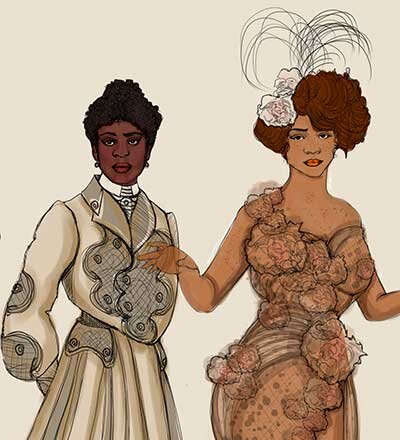The History behind Intimate Apparel

Costume design by Raquel Adorno.
By Kathryn Neves
This season at the Utah Shakespeare Festival, we’ll get a chance to see Intimate Apparel—a much-acclaimed play by Lynn Nottage. Set around the same time as this season’s musical, Ragtime, Intimate Apparel is a moving story of a young African-American seamstress at the turn of the twentieth century. This young woman, Esther, navigates the world of 1905 New York in a time of great political upheaval and social change. To really understand Esther and her world, we need to understand the history behind the play.
Just nine years before the start of the play, the U.S. Supreme Court passed what is widely considered one of the worst decisions it ever made. The case of Plessy v. Ferguson essentially created a “separate but equal” policy. This made it completely legal for discrimination based on race. As an African American woman in New York City, this case has a profound effect on Esther, essentially codifying into law her status as a “second-class citizen” due to her race.
Another key event in the racial history of America happened in the years before the play: the race riots of 1900 in New York City. After a black man, Arthur Harris, killed a police officer, large crowds of white men mobbed and rioted, attacking many black people in the city as retaliation. Reports of police brutality abounded, and none of the attackers faced legal repercussions. At the time of the play, Esther is living in a city still affected by the racial divisions caused by the riots.
As part of her job as a seamstress, Esther creates undergarments for women of all social classes, including a prostitute. In 1902, a report called The Social Evil was published in New York City, as a way to combat prostitution. This issue was at the forefront of the public consciousness at the time of the play.
Perhaps most significant of all is the Niagara Movement, which began in the year the play takes place. A group of African-American activists, led by W. E. B. Du Bois and William Monroe Trotter, created a group dedicated to widespread change in regards to racial relations in the U.S. The Niagara Movement sought to effect change by refusing to accommodate or compromise with racist policies. The push for racial equality was well underway at the turn of the century, and in Intimate Apparel, we see Esther living and working in the middle of it.
Intimate Apparelis so moving because of the history behind it. In a time of great political and social upheaval, we get an intimate, personal look at the life of a woman affected by all of it. We see the effects of history, not just on a grand scale, but on an individual level. In Intimate Apparel, we see the humanity behind the history. In Intimate Apparel, Lynn Nottage has created a character made more real and relatable by the history behind her.









